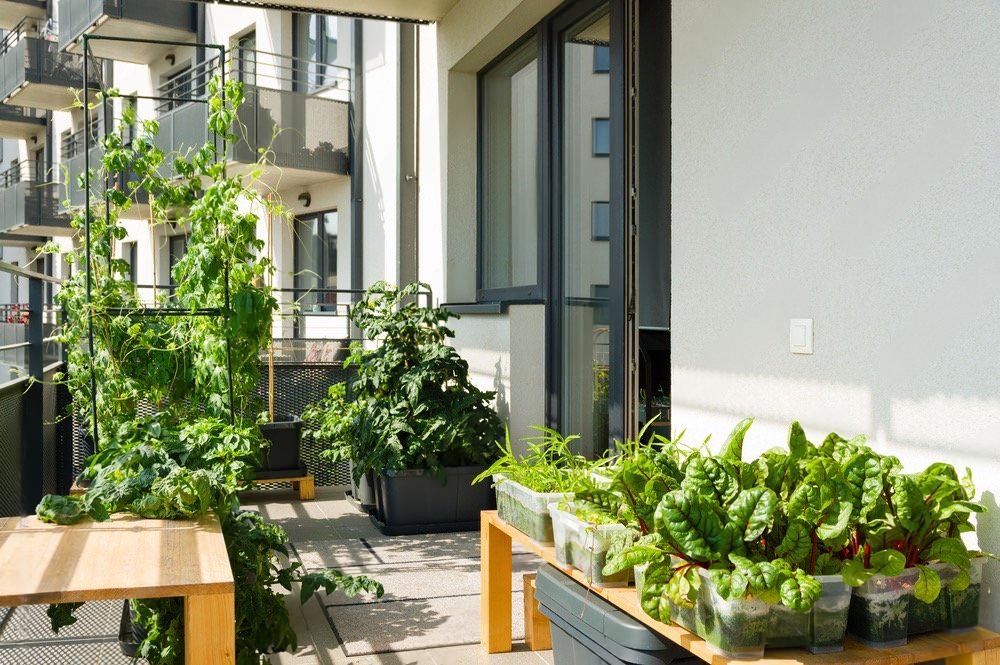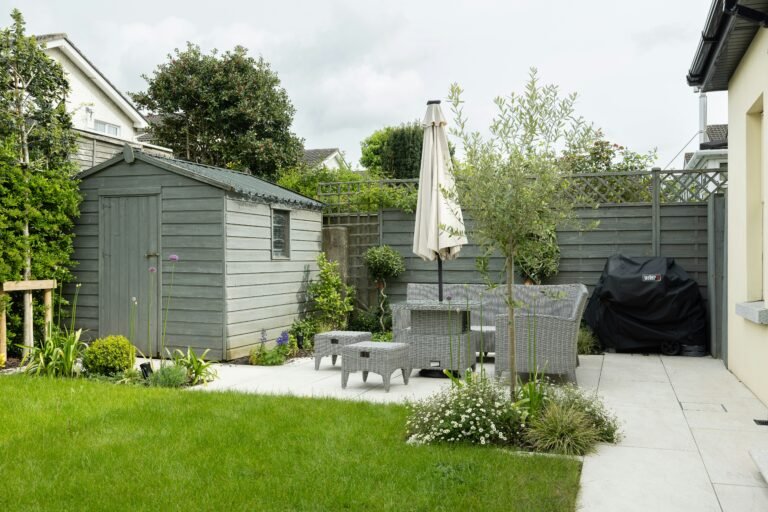I still remember the first time I turned my tiny balcony into a green corner — just a few pots, a wooden crate, and a string of fairy lights. Within weeks, that modest setup transformed my mornings: a cup of coffee surrounded by greenery, the city humming faintly below. That’s when I realized how powerful simple balcony garden ideas can be.
In urban living, outdoor space often feels like a luxury. Yet even the smallest balcony can become a lush retreat — a place to unwind, grow fresh herbs, or reconnect with nature without leaving home. The key is to make every square meter count with smart planning, creative use of vertical space, and the right choice of plants and containers.
This guide will show you how to bring your balcony to life, from clever design tips and container gardening solutions to maintenance routines that keep your plants thriving all year. Whether you dream of a cozy herb corner, a mini jungle, or a serene floral nook, you’ll find practical inspiration here to make it happen — no gardening degree required.
Ready to see how your small space can bloom into something truly special? Let’s dig in. 🌿
Why Balcony Gardens Are the Perfect Urban Oasis
In cities around the world, people are rediscovering the simple joy of growing their own green spaces. From compact herb gardens to lush vertical setups, urban gardening has become both a creative outlet and a statement of sustainability. Balconies — once overlooked or cluttered — are now being transformed into tranquil, functional sanctuaries.
According to The Guardian, more than half of city dwellers in Europe and North America have experimented with some form of balcony or indoor gardening in recent years. It’s a movement fueled by a growing desire to reconnect with nature, even when surrounded by concrete and glass.
Mental and Environmental Benefits
Creating a balcony garden isn’t just about aesthetics, it’s about wellness. Studies from the Journal of Environmental Psychology highlight that even a few plants can reduce stress, improve mood, and boost creativity. When you step onto your balcony and see life thriving in small pots, you’re reminded of growth and renewal every day.
Environmentally, balcony gardens also make a difference: they attract pollinators, filter air pollutants, and moderate indoor temperatures by providing shade and moisture. It’s a small but powerful act of urban rewilding.
Making the Most of Limited Space
When I first started my small balcony garden, I had barely enough room for a chair. But I learned that thoughtful choices — hanging baskets, railing planters, and layered greenery — could make even the tiniest corner feel lush. The secret is to think vertically and functionally: grow upwards, not outwards.
You don’t need a large terrace to enjoy the peace of a green retreat. With a few containers, some creativity, and consistent care, your balcony can become your personal oasis — a living space that breathes with you, reflects your personality, and adds daily joy.
Planning Your Small Balcony Garden
Before you bring in pots and plants, take a moment to truly understand your balcony. How much sunlight does it get during the day? Is it windy, shaded, or exposed to rain? These details determine what kind of plants will thrive. For instance, a south-facing balcony is ideal for sun-loving herbs and flowers, while a shaded one might suit ferns, ivy, or begonias.
Also, check the weight capacity of your balcony. Wet soil and ceramic containers can get heavy — a small but important detail often overlooked in balcony design. I learned this the hard way when an overloaded railing planter came loose during a storm! Taking the time to plan ahead prevents headaches later.
Choosing the Right Containers and Materials
Space is precious, so every container should earn its place. Use container plants that fit your aesthetic and climate: lightweight fiberglass pots, hanging baskets, or vertical planters that save floor space. Consider railing planters for herbs or succulents — they add color and texture without cluttering the ground.
Upcycled items can also work beautifully: wooden crates, tin cans, or even old teapots can become charming plant holders. Just make sure they have proper drainage holes.
For more clever ways to reuse materials and add personality to your setup, check out Upcycled Garden Decor Ideas for Sustainable Outdoor DIY Projects.
Budget-Friendly Design Tips
A lush balcony garden doesn’t have to cost much. You can repurpose materials like wooden pallets for shelving or make your own plant stands using bricks and planks. For inspiration, websites like Gardenista and Better Homes & Gardens offer creative, affordable ideas for balcony setups.
I like to sketch my layout before planting – deciding where to place taller plants for privacy, smaller ones for ground cover, and seating areas for comfort. Planning helps balance both function and beauty.
A little foresight, smart choices, and a touch of creativity can turn even the narrowest balcony into a green haven. The next step? Filling it with life.
Smart Balcony Garden Ideas for Small Spaces

Vertical Gardens and Green Walls
When space is limited, the best direction to grow is up. A vertical garden instantly multiplies your planting area while creating a beautiful natural backdrop. You can build one using wall-mounted pockets, trellises, or modular panels designed for vertical planting. Herbs like basil and parsley, or cascading plants such as ivy and pothos, thrive beautifully in these setups.
For renters or those on a budget, try a freestanding ladder shelf with pots — easy to move, stylish, and space-efficient. Vertical gardens not only maximize greenery but also act as sound and heat buffers, turning your balcony into a cooler, quieter retreat.
Layered Planting for Depth and Texture
Even a small balcony garden can look lush if you play with layers. Combine tall plants like bamboo or ornamental grasses at the back, medium-height flowering plants in the middle, and trailing species at the edges. This adds depth and a natural “mini-jungle” effect.
One of my favorite tricks is using tiered plant stands. They visually expand the space and make watering easier. Add plants with different leaf shapes and colors to create contrast — for example, pair deep-green ferns with bright marigolds or silver-leaved lavender.
Themed Mini Gardens
Giving your balcony a theme helps create harmony and focus. A herb garden is perfect for food lovers — fresh basil, mint, and thyme right outside your kitchen door. If you love color, try a “pollinator garden” with marigolds, petunias, and lavender to attract butterflies and bees.
Or perhaps you prefer a tropical vibe: mix palms, philodendrons, and bird-of-paradise with warm-toned lanterns and a rattan chair for that island feel. Themed gardens turn small balconies into immersive experiences — a reflection of your personality and lifestyle. With a thoughtful design, even the most modest balcony can bloom into a living piece of art.
Want to take your pollinator corner further? Discover simple habitat and planting tips in How to Create a Pollinator Friendly Garden for Bees & Butterflies.
Chapter 5: Best Plants for Your Balcony Garden
Sun-Loving vs. Shade-Loving Plants
The success of your balcony garden ideas largely depends on how well you match plants to your balcony’s light conditions. If you have a sunny, south-facing spot, choose sun-lovers like lavender, rosemary, geraniums, and succulents. These thrive under direct light and require less frequent watering.
For shaded or north-facing balconies, opt for plants that prefer cooler, lower-light environments. Ferns, peace lilies, begonias, and English ivy all perform beautifully without much sunlight. I personally love combining shade-friendly plants with light-colored containers to brighten up dim corners, a simple trick that makes the space feel airy and inviting.
Low-Maintenance Container Plants
Not everyone has the time to water and prune daily, and that’s okay. Plenty of container plants can thrive with minimal attention. Hardy herbs like thyme, oregano, and chives are both decorative and useful. For a touch of elegance, try dwarf evergreens or ornamental grasses, which stay vibrant year-round.
If you want color without the fuss, go for marigolds, zinnias, or portulaca — they handle heat and dryness gracefully. Websites such as RHS Gardening offer plant databases that help you filter species based on light, water, and maintenance levels.
Seasonal Rotation for Year-Round Beauty
A thriving small balcony garden changes with the seasons. In spring, fill your planters with tulips and pansies. Summer calls for heat-tolerant species like petunias or basil. As autumn approaches, swap them for chrysanthemums or ornamental kale, and in winter, evergreen shrubs or heather keep your space alive.
I enjoy this seasonal rhythm — it keeps the balcony fresh and gives me something new to look forward to each few months. Even in the coldest days, a few pots of greenery remind me that life persists and that spring always returns.
No matter your climate or experience level, there’s a plant palette to make your balcony bloom year-round.
Maintenance and Care Tips for a Thriving Balcony Garden

Watering and Drainage
Balcony plants live in limited soil, which means they dry out faster than garden beds. Proper watering is key to a healthy small balcony garden. Check moisture levels by touching the soil before watering — if it’s still damp, wait another day. Overwatering is just as harmful as drought.
Good drainage makes all the difference. Make sure every container has holes, and place saucers beneath them to catch excess water. For plants prone to root rot, mix perlite or small gravel into the soil. In hot months, I like to water early in the morning or late evening to reduce evaporation. If your schedule is busy, consider a simple drip irrigation kit or self-watering pots — they’re lifesavers.
Fertilizing and Soil Care
Container plants rely entirely on the nutrients you provide. A balanced, slow-release fertilizer keeps growth steady and foliage vibrant. Every few months, refresh the top layer of soil with compost or organic potting mix. For edible plants, choose organic fertilizers to ensure healthy, chemical-free harvests.
A tip I’ve learned: herbs such as basil or mint prefer light feeding, while flowering plants like geraniums and petunias thrive with more frequent fertilization. Adjust according to plant type and growth phase.
Pest Prevention and Plant Health
Even on high-rise balconies, pests like aphids or spider mites can find their way in. Inspect your plants weekly and look under leaves for signs of trouble. Instead of chemical sprays, use natural solutions such as neem oil, soapy water, or a light mist of vinegar (for tougher infestations).
Encourage beneficial insects like ladybugs by planting pollinator-friendly flowers. A little biodiversity goes a long way.
Keeping your balcony garden healthy doesn’t require perfection, just consistent attention and care. Once you build a simple routine, tending your plants becomes less of a chore and more of a relaxing ritual.
For more proven, chemical-free ways to handle pests, explore Natural Pest Control for Gardens: Proven Organic Solutions That Work.
Creating a Cozy Atmosphere in Your Balcony Garden
Lighting and Seating
Once your greenery is thriving, it’s time to turn your balcony into a true retreat. Thoughtful lighting transforms the mood completely. Fairy lights, solar lanterns, or small LED strips can cast a warm glow that invites you to linger even after sunset. I personally love stringing soft bulbs along the railing — it adds instant charm and makes the space feel magical.
For seating, opt for compact, foldable furniture or built-in benches with storage. Even a single chair and side table can make your balcony feel like an extension of your living room. Weatherproof cushions and throws add comfort and personality, making the space perfect for morning coffee or quiet evening reflection.
Personal Touches
Your balcony garden should reflect you. Decorate with items that tell your story — a hand-painted pot, a woven rug, or a favorite piece of wall art. You can even hang mirrors to visually expand the space or use small shelves to display plant cuttings and decorative stones.
Sustainability can also be part of the décor. Reuse old jars as candleholders, or upcycle driftwood into plant hangers. It’s amazing how these small details give the space warmth and individuality.
Using Scent and Sound
A truly lush retreat engages all the senses. Include aromatic plants like jasmine, lavender, or mint to fill the air with fragrance. Wind chimes or a miniature fountain can add gentle background sounds, masking city noise and enhancing relaxation.
Even on busy days, I find that spending just ten minutes surrounded by scent, light, and texture recharges me completely. It’s not about the size of the space — it’s about the feeling it evokes.
By layering comfort, creativity, and natural beauty, your balcony becomes more than a garden — it becomes your personal sanctuary.
Conclusion
When I look at my own balcony now — a few pots, some trailing vines, and a cozy chair tucked in the corner — I’m reminded how little it takes to create calm amid the city’s chaos. A well-planned balcony garden isn’t just decoration; it’s a small act of care for yourself and your surroundings.
Whether you start with one pot of herbs or design an entire vertical garden, every bit of greenery makes your space more alive. Over time, you’ll notice how tending to plants changes your rhythm — watering becomes a mindful pause, and watching new leaves unfurl brings a quiet joy that screens can’t match.
The beauty of these balcony garden ideas is that they grow with you. As your confidence and creativity expand, so does your little oasis. So step outside, feel the breeze, and start small — your lush retreat is just a few plants away.
👉 Ready to bring more beauty and calm into your home? Explore more outdoor and design inspiration at HomelyHaven, where small spaces meet big ideas.
Alex is the creator of Homely Haven, a space dedicated to simple, stylish ideas for interiors and gardens alike. With a passion for cozy living rooms, inviting outdoor spaces, and practical DIY solutions, Alex shares tips and guides that help turn any house into a true home.
From budget-friendly decorating hacks to weekend garden projects, the goal is always the same: to inspire you to create spaces that feel personal, beautiful, and welcoming. When not writing, Alex is usually rearranging furniture, sketching new garden layouts, or exploring design trends for the next project.








